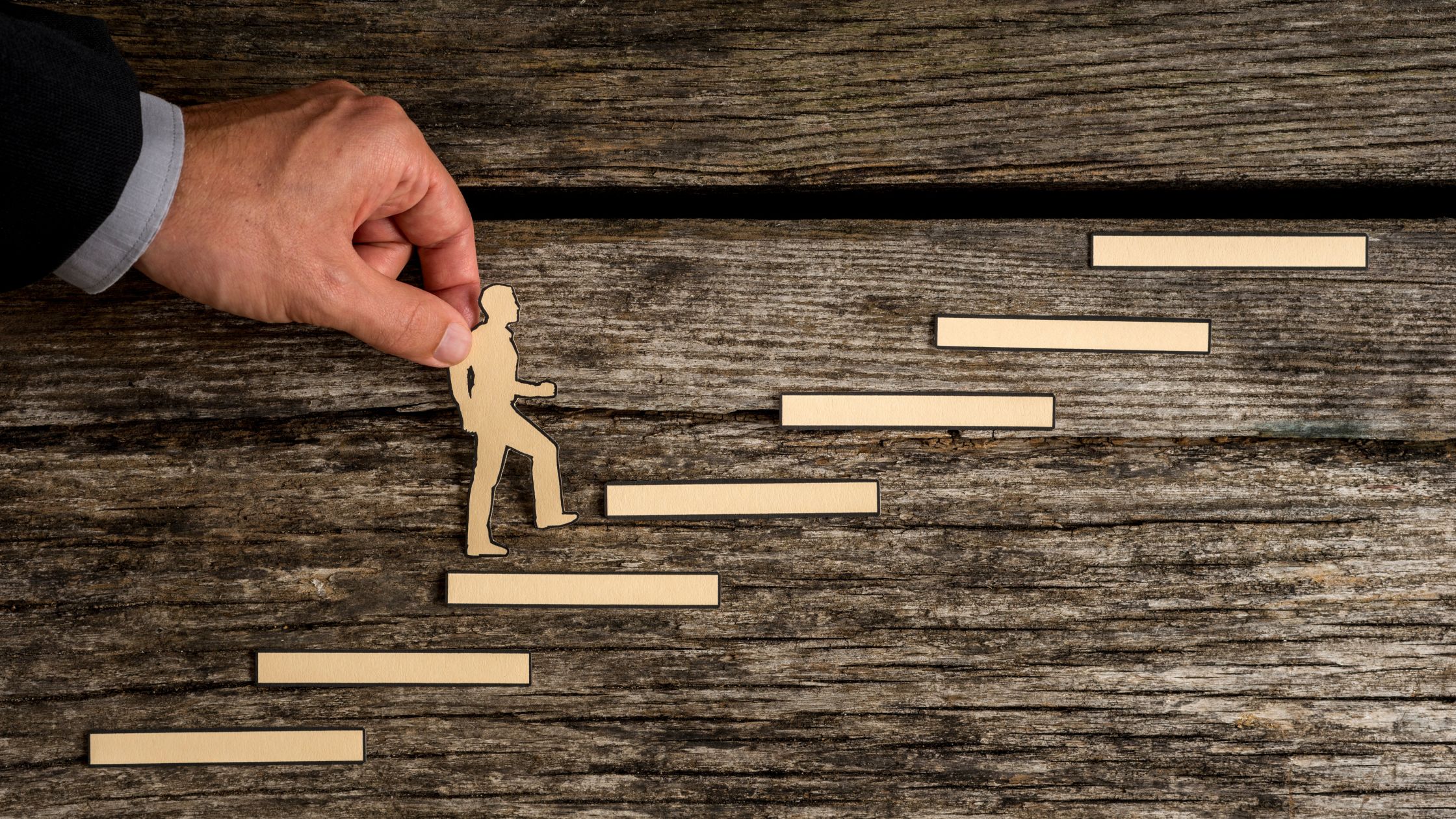Giving up on our goals chips away our confidence, stalls personal & professional growth, and blocks forward momentum. Read on for a potent plan to make continual progress and ensure you don’t slide back.

“No matter how hard you try, you can’t fall off the floor.”
The cost of giving up our goals is high. It affects everything from our future potential to our present mental health. There’s also a high energy and time cost. You can learn to stop giving up by adopting what I call the “Floor and Ceiling Method” for key parts of daily behavior related to your goals.
Done well, and implemented right, crafting your Floor and Ceiling will help propel you forward while preventing those tricky slips and slides down the mountain of progress back to the beginning. It also helps you slowly and gently raise your outcome bar progressively, if that’s something you desire (sometimes more isn’t ideal). You can make progress/aim for better or more without putting extra pressure on yourself.
What this is then is both your framework to move forward as well as your safety net to prevent adding stress to the journey. A low-stress journey usually helps reversion back to the old status quo, while protecting your mental and physical wellbeing in the process.
The four attributes of goal progress:
(1) Clarity (and specificity) — You can read more about how to get essential goal clarity here:
(2) Strong desire & and intention (bordering on obsession) — You really have to want it, you need to know why it matters, and visualize what it looks like.
(3) Action Plan – Your overall action plan isn’t the topic of discussion here, and we’ll have another article that gets into how to craft a goal action plan. But I’ll give you a quick synopsis of what works very well:
Take the big goal and break it down to a sub-goal achievable in 3 months. This is pretty much how far the brain can realistically process working towards something. Beyond this we start getting into abstraction, which means it feels so big (too big) that you’ll push it off and never actually make progress.
So now you have your realistic 3-month goal. Next, break that down into a Month 1 milestone. Milestone = a result you can measure or quantify, and the general gist of actions (just bullet a few points) it would take to hit that target. Repeat this for Month 2 & Month 3.
Now, we only focus on the Month 1 Milestone. Create mini-milestones for each week. [Remember, a milestone (or here a mini-milestone) has two attributes: (a) quantifiable measurement; (b) list of general actions (few bullet points) to get there.] By the end of this, you’ll have a general roadmap for the actions you need to take to hit your target each week and check off all 4 mini milestones.
Tip: don’t over plan-.Do mini-milestones for only Month 1. Get specific about the list of actions for Week 1 as that’s right in front of you. Don’t get overly detailed about Week 2-4 actions right now because you’ll need to stay fluid and adaptable, incorporating what you learn/process and the insights you gleam as you go.
Finally, break into 1-2 concrete daily priorities and as many subtasks as needed. That all depends on the complexity of the goal. For instance, if it’s a main part of your business or sales plan, you’ll need more subtasks. If it’s a personal development goal, hobby, or healthy habit, it won’t require the same type of subtasks.
Tip: the subtasks are easy to turn into Pomodoro sessions.
Now here and in #4 is where our configuration of our floor-and-ceiling will come into play. We’ll get into this below.
(4) Consistency. This is also where floor-to-ceiling system is a goal-saver / game-changer.
So, as you can see we’ll hone in with particular focus on #3 and #4 as the lack of a *REALISTIC* Action Plan and Consistency with Implementation are the main reasons people stop forward progress on goals and even slide backwards into undesirable behavior. Learning floor-to-ceiling is going to help you change all that.
Read on to understand, design, and implement this impenetrable method that is going to ensure you learn how to stop giving up and falling off your goals!

What is the Floor-and-Ceiling Method?
This is both a mindset and a logistics plan to support your daily progress forward and especially prevent (a) stagnation, (b) giving up, (c) and the dreaded slippery slope down to reactionary or negative habits
Tip: even if this goal doesn’t involve correcting a negative habit, one can manifest because the Emotional guilt from not going forward / giving up often loops into a new reactionary/numbing coping mechanism because you feel bad about yourself and want to escape. Obviously, this is the last thing we want when aspirational goal setting (which is all about improving status quo) but often what happens without good floor-and-ceiling. This is also why after a few cycles of this loop, folks give up entirely and revert back to their old comfort zone.
#1 – Stop Giving Up Your Goals: The Floor is Your Daily Baseline (Your M.E.D.)
Simply put, M.E.D. stands for “Minimum Effective Dose.” What is the Minimum Effective Dose of a habit, practice, or task that you need to do to have an impactful effect?
In pharmacotherapy, we have a range for therapeutic efficacy of a medicine. What’s the lowest needed in the blood or at the site of action to create the intended action?
This is similar to that. But here your M.E.D. has nothing to do with a real med, and everything to do with your baseline action that needs to be taken to achieve that day’s goal breakdown (the 1-2 tasks you take to make sure you hit that mini weekly milestone).
Let me give you two real world examples:
EXAMPLE NUMBER 1: You want to increase your sales/earnings. You set a concrete 3 month goal with the sales target and a brainstormed lists of actions you can take to get there. You create your Monthly milestones with numbers to hit the gist of actions you’ll focus on each month (might be the same month-to-month, perhaps you switch up your customer profile or try a new form of prospecting in month 2).
For month 1, you get specific about a list of actions you can take to hit that Month 1 Milestone. Then you break it into those mini-milestones for 4 weeks. (Tip: Doing these mini-milestones helps you win in two ways: (1) It helps you visualize success for the week; (2) It bridges your big-picture goal (aspirational) with the day-to-day (actionable). This relation is vital to good execution.)
Now you’re in the final stage of breaking down that Week’s mini milestone into daily priorities/associated tasks.
Here’s where your M.E.D. comes in to create your floor: What’s the least you’re going to do to feel the smallest, but tangible sense of progress each day. Maybe your M.E.D. is reaching out to 5 new people on LinkedIn or sending out 5 emails to clients outside your ideal customer base.
Again, depending on the complexity of the goal, the time & number of tasks devoted to it, and its overall weight in your life/work – your M.E.D. is going to vary. We know goals come in all shapes and sizes.
The key here. And this is the absolute KEY: Your M.E.D. has to be very realistic — so realistic that it is doable no matter the external circumstances (new or unexpected challenge, distraction, etc.) or your internal state (emotional energy, physical energy, mood.) Why?
Because YOU are going to do your M.E.D. irrespective of whatever else is going on inside or outside. There are no excuses when it comes to your M.E.D. — this is your habit vitamin. This is your floor. This is how we make sure you truly digest how to stop giving up and falling off your goals.
This bare minimum is not up for debate, analysis, thought, or circumvention. (Obvious exceptions include serious illness, trauma, etc.)
EXAMPLE NUMBER 2: Your goal is regular physical activity in your life. You go through the process of setting your 3-month goal, monthly milestones, weekly mini milestones, etc.
Now here’s where it comes time to decide what is the bare minimum you can and will commit to doing every day. It’s time to know your floor or your M.E.D.
I’ll tell you mine: I do interval running for just one mile every day. This takes me 15 minutes. 15 minutes is totally doable for me. 15 minutes is even fun. I get to listen to pumped up music and get my dopamine and endorphins firing. My brain is in the zone. It’s a natural anti-anxiety (check out the book Spark) M.E.D. & med, and gets me excited for the day.
Now, about two days a week my legs are sore/ muscles stiff. I don’t skip those days. I just walk instead and do some extra stretching. BOOM. That’s my beautiful, implementable, actionable, joyful activity M.E.D.
Tip: When you think about your M.E.D, what’s going to get you excited? What other sensory factors can you add in to make your M.E.D. fun if that’s doable? Music, a podcast, being in nature. What is realistic? What will you commit to (and minutely tweak if needed) to make sure you don’t halt progress or do the dreaded slide back?

#2 – How to Stop Giving Up Your Goals: The Ceiling is Your Aspirational without Overkill – (your A.I.M.s)
Let’s talk about A.I.M.s in another article (Tip: I love acronyms because they’re amazing mnemonics which go beyond memory but allow your brain to see and act in patterns, which it loves to do. This also frees up cognitive and energetic bandwidth.)
Your A.I.M. is your Absolute Ideal Maximum. Like M.E.D.s this comes up in a lot of different contexts when applied to life and work systems, as well as behavioral psychology.
Your A.I.M. is your ceiling. What is the most you’re going to bust out on the best days where your external and internal circumstances are solid. These are for the days you’re in the zone, able to step into flow, and work/perform like you’re a seasoned elite athlete just playing a low stakes pre-season game. What I mean is – your confidence is high, your career isn’t riding on the A.I.M. attainment, and you can even enjoy yourself.
Why are the stakes low? Because you don’t have to do your A.I.M. — you just gotta do your M.E.D. There’s no pressure, you’re just making the most out of favorable conditions.
Now the KEY with designing your A.I.M. is a little different than what you might expect me to say. It’s not to go all out and be 5-10 levels above your M.E.D., it’s to only be 3-4 levels above your M.E.D. In other words — don’t fly too high Icarus or you’ll get burned by the sun.
What I mean here (and please pay close attention because this is one of the top reasons people keep up the cycle of quitting) — you’re going to burn out fast if you’re A.I.M. is too high. By trying to be EXTRA/ do the MOST/ get your max hustle on – whatever turn of phrase suits you here — you are busting out of the upper limits of your system and breaking it top down.
This is doable once or twice, but energy doesn’t work that way. The laws of thermodynamics tell us that there’s an equal and opposite reaction for every action. So A.I.M. too high, you’re not engaged in a sustainable process. You’ll overtire yourself, slip, fall off doing your M.E.D.s for a few days, and eventually QUIT.
Your Key Takeaways on How to Stop Giving Up on Your Goals
Takeaway #1 – Finesse your floor-and-ceiling design with balance. The gap between M.E.D. and A.I.M. should be incremental (1-2 levels) not radical.
Think about the height of a standard room. Sure, it might have vaulted ceilings and be larger than average, but usually the space between floor and ceiling is fairly standard. 12 feet, 16 feet, maybe 20 feet. But not 100 feet. Unless we’re talking some old palace or castle, we measure the height of buildings in fairly standard stories.
Similarly, your M.E.D. should be doable, achievable, reproducible daily irrespective of circumstance (internal or external). Your A.I.M. should be slightly more aspirational for those ideal days when no emergencies have come up and you’re in the zone. You’re feeling good, in flow, and able to push a bit harder. The gap between the two should not be much.
Slowly, you’ll learn to periodically assess your ceiling and raise it up higher if that’s what you want. It’s not a forever limitation of your outcome or reflection of your abilities. It’s your way of moving to create momentum, achieving the doable, and increasing the target in a sustainable, joyful way.
Takeaway #2 – Consistence is Key – Persist in Your System without Overanalyzing
Another way we waste time and energy is hyper analyzing how it’s going and getting bummed out about the results. Tip: You’re not going to see the results you want in the first few weeks. Keep going. Trust. That’s why you created your Mini-Milestones for all four weeks of Month #1.
Now, I did mention not to be too specific about the tasks you’re going to be engaging in in the later weeks right off the bat. This is true. Finely tweak your M.E.D. and your A.I.M. for Weeks 2-4. But don’t blow them out of the water by completely changing them. You are not in a position to evaluate whole-scale and just toss them away.
This is because you are in what I call the “change-phase.” In the change-phase, your effort is high, your internal resistance is high, and your visible results are low. You are not going to enjoy the change-phase too much, but it keeps getting easier. Literally, day-by-day, it gets easier. In a few weeks, you’ll notice the shift. You’ll also face much less internal resistance. So, just keep doing your M.E.D.s without much alteration. Only minor tweaks allowed that first month.
For example, you might find that a task is actually more time consuming (often happens) than you budgeted for when designing your original M.E.D. — okay, scale it down a notch or two. But don’t say, “oh this sucks, I’m getting nowhere.” Because scrapping it altogether will get you nowhere.
Experience the extraordinary with our groundbreaking Neuro-performance program, unleashing the power of your hidden genius. Over the course of just 10 weeks, witness a remarkable transformation that permeates every facet of your life: career, daily performance, health, wellness, cognitive function, habits, relationships, energy, and personal and spiritual growth. What sets us apart is our unwavering focus on the brain as the ultimate catalyst for change.
Discover the multitude of genius flavors and types that reside within you, as we guide you through a journey of learning, self-discovery, and profound metamorphosis into your highest self. To witness the magic firsthand, explore our home-page brimming with captivating videos that promise to inspire and revolutionize your life. Take the first step today and embark on the path to unlocking your true potential. Come check out our new content on our homepage for some amazing videos that will inspire and change your life.
If you enjoyed this article, we'd love for you to forward it to your community! It helps us to help more people. Use the social/mail icons to share it with anyone in 2 seconds.
